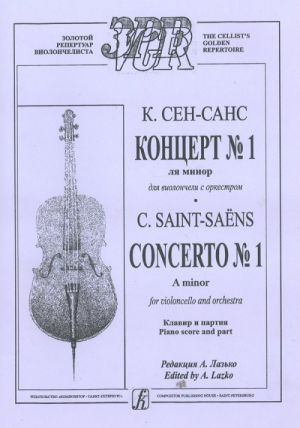The second half of the 19th century became the true "golden age" of the world cello performing art. It was exactly that time, when cello repertoire was enriched with the masterpieces as the concertos by R. Schumann and E. Lalo, variations by P. I. Tchaikovsky and most brilliantly crowned with the concerto by Dvorjand the Concerto for violin and cello by J. Brahms. The Concerto A minor for violoncello and orchestra by Camille Saint-Saens is ranked among these creams of world cello crops, having drawn musicians by its novelty and simultaneously miraculous balanced construction, fascinating, nearly transcendental virtuosity passing the verge of piano's abilities and vivid orchestration, so as the anguishing ampleness of romantic music.
The Concerto shall no doubt go on hitting marks on the field of world music treasury until there exists the instrument called violoncello.
The second half of the 19th century became the true "golden age" of the world cello performing art. It was exactly that time, when cello repertoire was enriched with the masterpieces as the concertos by R. Schumann and E. Lalo, variations by P. I. Tchaikovsky and most brilliantly crowned with the concerto by Dvorjand the Concerto for violin and cello by J. Brahms. The Concerto A minor for violoncello and orchestra by Camille Saint-Saens is ranked among these creams of world cello crops, having drawn musicians by its novelty and simultaneously miraculous balanced construction, fascinating, nearly transcendental virtuosity passing the verge of piano's abilities and vivid orchestration, so as the anguishing ampleness of romantic music.
The Concerto shall no doubt go on hitting marks on the field of world music treasury until there exists the instrument called violoncello.
Вторая половина XIX века стала поистине золотым временем в истории виолончельного искусства. Именно тогда репертуар виолончелистов обогатился такими шедеврами, как концерты Шумана, Лало, Вариации Чайковского, и, в завершение этого благословенного периода, концертом Дворжака и концертом для скрипки и виолончели Брамса. В этом ряду достойное место занимает быстро завоевавший мировую известность ля-минорный концерт для виолончели с оркестром К. Сен-Санса. Произведение сразу привлекло новизной и, в то же время, удивительной стройностью формы, виртуозностью, которая нигде не переходит грань естественных возможностей инструмента, чуткой и одновременно яркой оркестровкой, а главное, завораживающим мелодическим богатством романтической музыки.
Концерт уже прошел проверку временем. И пока живет виолончель, не подлежит забвению и это великолепное сочинение Сен-Санса.
Vtoraja polovina XIX veka stala poistine zolotym vremenem v istorii violonchelnogo iskusstva. Imenno togda repertuar violonchelistov obogatilsja takimi shedevrami, kak kontserty Shumana, Lalo, Variatsii Chajkovskogo, i, v zavershenie etogo blagoslovennogo perioda, kontsertom Dvorzhaka i kontsertom dlja skripki i violoncheli Bramsa. V etom rjadu dostojnoe mesto zanimaet bystro zavoevavshij mirovuju izvestnost lja-minornyj kontsert dlja violoncheli s orkestrom K. Sen-Sansa. Proizvedenie srazu privleklo noviznoj i, v to zhe vremja, udivitelnoj strojnostju formy, virtuoznostju, kotoraja nigde ne perekhodit gran estestvennykh vozmozhnostej instrumenta, chutkoj i odnovremenno jarkoj orkestrovkoj, a glavnoe, zavorazhivajuschim melodicheskim bogatstvom romanticheskoj muzyki.
Kontsert uzhe proshel proverku vremenem. I poka zhivet violonchel, ne podlezhit zabveniju i eto velikolepnoe sochinenie Sen-Sansa.













